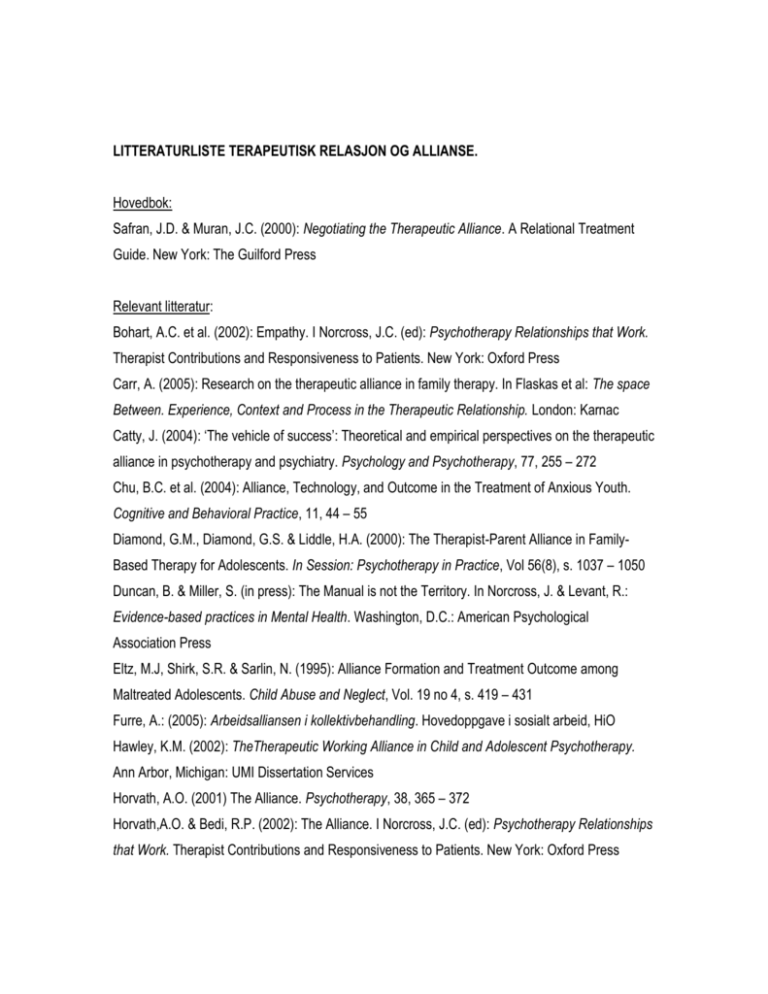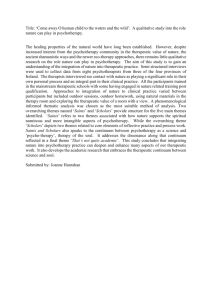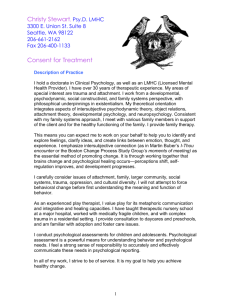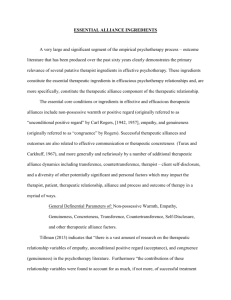Terapeutisk relasjon og allianse
advertisement

LITTERATURLISTE TERAPEUTISK RELASJON OG ALLIANSE. Hovedbok: Safran, J.D. & Muran, J.C. (2000): Negotiating the Therapeutic Alliance. A Relational Treatment Guide. New York: The Guilford Press Relevant litteratur: Bohart, A.C. et al. (2002): Empathy. I Norcross, J.C. (ed): Psychotherapy Relationships that Work. Therapist Contributions and Responsiveness to Patients. New York: Oxford Press Carr, A. (2005): Research on the therapeutic alliance in family therapy. In Flaskas et al: The space Between. Experience, Context and Process in the Therapeutic Relationship. London: Karnac Catty, J. (2004): ‘The vehicle of success’: Theoretical and empirical perspectives on the therapeutic alliance in psychotherapy and psychiatry. Psychology and Psychotherapy, 77, 255 – 272 Chu, B.C. et al. (2004): Alliance, Technology, and Outcome in the Treatment of Anxious Youth. Cognitive and Behavioral Practice, 11, 44 – 55 Diamond, G.M., Diamond, G.S. & Liddle, H.A. (2000): The Therapist-Parent Alliance in FamilyBased Therapy for Adolescents. In Session: Psychotherapy in Practice, Vol 56(8), s. 1037 – 1050 Duncan, B. & Miller, S. (in press): The Manual is not the Territory. In Norcross, J. & Levant, R.: Evidence-based practices in Mental Health. Washington, D.C.: American Psychological Association Press Eltz, M.J, Shirk, S.R. & Sarlin, N. (1995): Alliance Formation and Treatment Outcome among Maltreated Adolescents. Child Abuse and Neglect, Vol. 19 no 4, s. 419 – 431 Furre, A.: (2005): Arbeidsalliansen i kollektivbehandling. Hovedoppgave i sosialt arbeid, HiO Hawley, K.M. (2002): TheTherapeutic Working Alliance in Child and Adolescent Psychotherapy. Ann Arbor, Michigan: UMI Dissertation Services Horvath, A.O. (2001) The Alliance. Psychotherapy, 38, 365 – 372 Horvath,A.O. & Bedi, R.P. (2002): The Alliance. I Norcross, J.C. (ed): Psychotherapy Relationships that Work. Therapist Contributions and Responsiveness to Patients. New York: Oxford Press Lambert, M.J. & Barley, D.E. (2002): Research Summary on the Therapeutic Relationship and Psychotherapy Outcome. I Norcross, J.C. (ed): Psychotherapy Relationships that Work. Therapist Contributions and Responsiveness to Patients. New York: Oxford Press Nerdrum, P. & Rønnestad, M. H. (2002) The trainees' perspective: A qualitative study of learning empathic communication. The Counseling Psychologist, 30, 609-629. Puschner, B., Bauer, S., Horowitz, L.M. & Kordy, H. (2005): The Relationship Between Interpersonal Problems and the Helping Alliance. Journal of Clinical Psychology, Vol. 61(4), 415429 Reimers, S. (2001): Understanding alliances. How can research inform user-friendly practice? Journal of Family Therapy 23(1): 46-62 Rønnestad, M. H. (2000). Psykoterapiforskning: Noen utviklingslinjer og betraktninger om "the Dodo bird verdict": "Everybody has won and all must have prizes." Tidsskrift for Norsk Psykologforening, 37, 1003-1016. Shirk, S.R. & Karver, M (2003): Prediction of Treatment Outcome From Relationship Variables in Child and Adolescent Therapy: A Meta-Analytic Review. Journal of Consulting and Clinical Psychology, vol 71 (3), s. 452 - 464 Shirk, S.R. & Saiz, C. (1992): The therapeutic alliance in child psychotherapy. Clinical, empirical and developmental perspectives. Development and Psychopathology 4, 713 – 728 Summers, R.F. & Barber, J.B (2003): Therapeutic Alliance as a Mesurable Psychotherapy Skill. Academic Psychiatry 27:3 Symonds, D. & Horvath, A.O. (2004): Optimizing the Alliance in Couple Therapy. Family Process, vol. 43, no. 4, 443 - 456 Tryon, G.S. & Winograd, G. (2002): Goal Consensus and Collaboration. I Norcross, J.C. (ed): Psychotherapy Relationships that Work. Therapist Contributions and Responsiveness to Patients. New York: Oxford Press







![UW2 - Psychiatric Treatments [2014]](http://s3.studylib.net/store/data/006859622_1-db6167287f6c6867e59a56494e37a7e7-300x300.png)